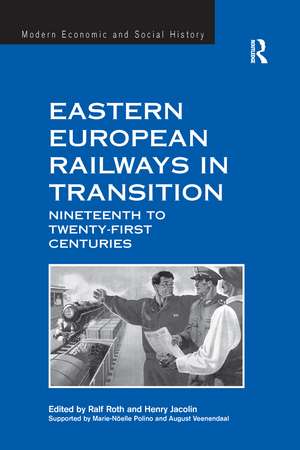Eastern European Railways in Transition: Nineteenth to Twenty-first Centuries
Autor Henry Jacolin Editat de Ralf Rothen Limba Engleză Paperback – 9 sep 2016
| Toate formatele și edițiile | Preț | Express |
|---|---|---|
| Paperback (1) | 469.34 lei 6-8 săpt. | |
| Taylor & Francis – 9 sep 2016 | 469.34 lei 6-8 săpt. | |
| Hardback (1) | 1065.96 lei 6-8 săpt. | |
| Taylor & Francis – 22 aug 2013 | 1065.96 lei 6-8 săpt. |
Preț: 469.34 lei
Nou
Puncte Express: 704
Preț estimativ în valută:
89.82€ • 93.43$ • 74.15£
89.82€ • 93.43$ • 74.15£
Carte tipărită la comandă
Livrare economică 14-28 aprilie
Preluare comenzi: 021 569.72.76
Specificații
ISBN-13: 9781138246980
ISBN-10: 1138246980
Pagini: 432
Dimensiuni: 156 x 234 x 25 mm
Greutate: 0.45 kg
Ediția:1
Editura: Taylor & Francis
Colecția Routledge
Locul publicării:Oxford, United Kingdom
ISBN-10: 1138246980
Pagini: 432
Dimensiuni: 156 x 234 x 25 mm
Greutate: 0.45 kg
Ediția:1
Editura: Taylor & Francis
Colecția Routledge
Locul publicării:Oxford, United Kingdom
Recenzii
'For the British reader, it offers a totally different perspective on why railways were built and the impact of political change. War, revolution and the redrawing of national boundaries had frequent and often drastic impact on networks built for strategic purposes that then vanished, or for internal transport then bisected by a new border.' Journal of the Railway and Canal Historical Society '... throughout, the volume offers stimulation and reflection for both specialist and generalist reader.' Journal of Transport Geography
Cuprins
Introduction: Eastern European Railways in Transition Part I: General Suggestions and Historical Overviews of Railways in Eastern European Countries 1 The Baltic States – Railways under Many Masters 2 The Construction and Modernisation of Railways in Belorussia/Belarus in the Late Nineteenth and Twentieth Centuries 3 Serbia’s Access to the Sea, 1830–2006 4 The History of Railway Passenger Transportation in Hungary – From the Monarchy to the Twenty-First Century 5 Czech Military Railways – History and a Comparative Analysis of the Czech Railway Network’s Efficiency 6 The Royal Prussian Eastern Railway (Ostbahn) and its Importance for East–West Transportation Eastern European Railways in Transition Part II: Under Russian Protection 7 1918, 1945 and 1989: Three Turning Points in the History of Polish Railways in the Twentieth Century 8 Transport under Socialism: The Case of the Czechoslovak State Railways 1948–1989 9 The Modernisation of Railways in Slovakia after 1945 10 The Centrally Planned Economy and Railways in Hungary 11 The Railways of the Ukrainian Soviet Socialist Republic: 1920–1990 12 Yugoslavia: The Sub-Savian Magistral 13 Passengers’ Railway Identity in Socialist Romania during the 1950s and 1960s 14 Cold War Crisis on the Railway: Construction of the Berlin Wall Part III: After the Fall of the Iron Curtain: Changes – Problems – Modernisation15 Railway Integration in Europe: UIC – a Key Player of East–West Railway Integration 16 Back to the Future? Russia’s Railway Transport and the Collapse of the Soviet Union in Historical Perspective 17 The Unification of East and West German Railways into the Deutsche Bahn 18 Seen from the Driving Cab: The Consequences of German Railway’s Privatisation since the Reunion of Deutsche Bundesbahn and Reichsbahn from the Engine Drivers’ Perspective 19 The Reopening of Murska Sobota–Zalalöv? Railway: A Paradox of the European Reunification in Central Europe? 20 ‘More is Less’: Regular Interval Timetable in Central Eastern Europe 21 Railway Heritage Protection Policy in Hungary 22 The Heritage of the Deutsche Reichsbahn and its Presentation in the Deutsche Bahn Museum in Nuremberg
Descriere
In this volume, leading transport history scholars take a fresh look at the impact of the Cold War upon European railways both before and after 1989. As well as addressing the development of eastern and central European railways, the book examines how transport links have been reconnected and reconfigured in the twenty years since the reunification of Europe. In particular, it focuses upon the former communist countries and how they have responded to the challenges and opportunities railways offer both nationally and internationally.














